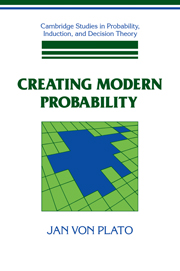Book contents
- Frontmatter
- Contents
- Preface
- 1 Introduction
- 2 Pathways to modern probability
- 3 Probability in statistical physics
- 4 Quantum mechanical probability and indeterminism
- 5 Classical embeddings of probability and chance
- 6 Von Mises' frequentist probabilities
- 7 Kolmogorov's measure theoretic probabilities
- 8 De Finetti's subjective probabilities
- Supplement: Nicole Oresme and the ergodicity of rotations
- Bibliography
- Index of Names
- Index of Subjects
6 - Von Mises' frequentist probabilities
Published online by Cambridge University Press: 05 June 2012
- Frontmatter
- Contents
- Preface
- 1 Introduction
- 2 Pathways to modern probability
- 3 Probability in statistical physics
- 4 Quantum mechanical probability and indeterminism
- 5 Classical embeddings of probability and chance
- 6 Von Mises' frequentist probabilities
- 7 Kolmogorov's measure theoretic probabilities
- 8 De Finetti's subjective probabilities
- Supplement: Nicole Oresme and the ergodicity of rotations
- Bibliography
- Index of Names
- Index of Subjects
Summary
MECHANICS, PROBABILITY, AND POSITIVISM
Richard von Mises was an applied mathematician. He first specialized in mechanics, hydrodynamics especially. By applied, he really meant it: A book of 1918, for example, dealt with the ‘elements of technical hydromechanics.’ Another related specialty was the theory of flight, much in vogue early on in the century. His work on probability starts properly around 1918, and from the same time are his first writings on foundational problems in science: on foundations of probability in 1919, and on classical mechanics in 1920. Von Mises' philosophical book Wahrscheinlichkeit, Statistik und Wahrheit of 1928 was the third volume in the Vienna Circle series ‘Schriften zur wissenschaftlichen Weltauffassung’, edited by Philipp Frank and Moritz Schlick. The year 1931 marked the publication of von Mises' big book on probability theory, Wahrschein-lichkeitsrechnung, whose exact title adds, ‘and its application in statistics and theoretical physics.’ The posthumous Mathematical Theory of Probability and Statistics is based on lectures from the early 1950s.
Von Mises was a declared positivist, identifying himself with the philosophy of the Berlin group, the Vienna Circle, and the Unity of Science Movement. His Kleines Lehrbuch des Positivismus (1939) appeared in an English version in 1951 as Positivism: A Study in Human Understanding. It attempts to give a broad presentation of the logical empiricist world view, from foundations of knowledge and the sciences to morals and society.
- Type
- Chapter
- Information
- Creating Modern ProbabilityIts Mathematics, Physics and Philosophy in Historical Perspective, pp. 179 - 197Publisher: Cambridge University PressPrint publication year: 1994

